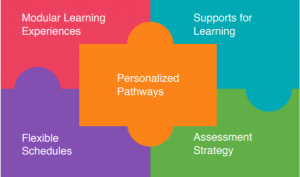Meeting Students Where They Are
CompetencyWorks Blog
 iNACOL, CompetencyWorks, and reDesign released the final version of Meeting Students Where They Are today that was prepared for the 2017 National Summit on K-12 Competency-Based Education. It’s a fascinating paper – I’ve read it a zillion times and I learn something new every time. (FYI: reDesign has a lot of other great resources on mastery learning on their website.)
iNACOL, CompetencyWorks, and reDesign released the final version of Meeting Students Where They Are today that was prepared for the 2017 National Summit on K-12 Competency-Based Education. It’s a fascinating paper – I’ve read it a zillion times and I learn something new every time. (FYI: reDesign has a lot of other great resources on mastery learning on their website.)
Figuring out how to “meet students where they are” to ensure they are repairing gaps, reaching proficiency, able to access rigorous (as in higher order skills) learning, and growing at a rate that will prepare them for college and careers close to age 18 (because few high school students want to hang out in high school after their friends leave) is one of the biggest challenges we are facing. Too often schools are still organized to deliver grade-level standards or they revert back to something that looks horrifically close to tracking. There is a third way (and I’m guessing a fourth and fifth way) – and reDesign sketches out what it can look like.
There are a lot of resources in this paper, and my number one recommendation if you don’t do anything else is to watch Austin’s Butterfly. I had seen it in another context and I’ve never recovered: I had never realized how low my expectations of children were. Watching this video really helped me understand what strong question-asking, effective feedback, and opportunity for revision means for learning.
https://www.youtube.com/watch?v=dOSiU42P8Gc
I’ve also come to realize that none of us operate with one zone of proximal development. We can say “the” zone of proximal development, but in fact the breadth and depth of that zone is based on several variables:
- Where the student is emotionally and in terms of ability to persevere through productive struggle;
- The instructional strategies that the teacher knows or is comfortable with;
- The level of intensity of support and time dedicated to helping the student achieve; and
- The moderated understanding of what proficiency means or how well someone has to do something in order for it to be deemed proficient.
I think we need to create some common language in order to think about how to organize schools and learning experiences to allow for the level of support and revision featured in Austin’s Butterfly as compared to one that only got him to the second revision.
The topic of meeting students where they are is also one of the key issues that lands smack dab in the overlap of personalized learning and competency-based education. Thus, as schools build their capacity to meet students where they are, they will also be fully integrating these two highly-related approaches into the core of next generation education models.
Thanks to all the people that contributed to the development of this paper in the Technical Advisory Group on Meeting Students Where They Are: Amy Allen, Sharyl Allen, Mandi Bozarth, Michelle Bishop, Colleen Broderick, Michael Burde, Harvey Chism, Randy Dehoff, Pat Fitzsimmons, Cynthia Freyberger, Michael Klein, Tim Kubik, Christine Landwehrle, Diana Lebeaux, Paul Leather, Kathleen McClaskey, Christine McMillen, Caroline Messenger, Fritz Moser, Nikolaus Namba, Shawn Parkhurst, Alfonso Paz, Karla Esparza-Phillips, Blair Rush, Andrea Stewart, Jon Vander Els, Brenda Vogds, Jennifer Wolfe, and Mike Wolking.